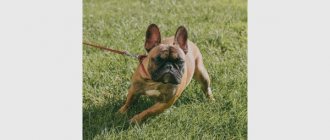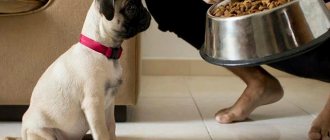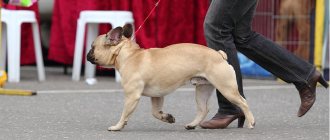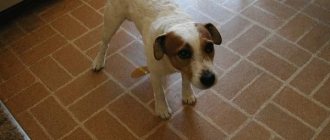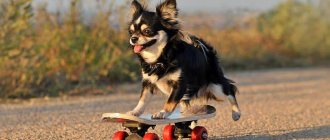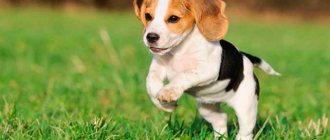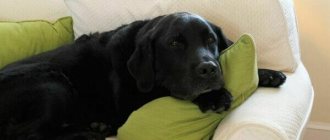The French Bulldog is an extremely popular breed of dog, which is inferior to its larger counterparts solely in size.
Due to their compact size, dogs of this breed do well even in small apartments.
In addition, they are very easy to care for and extremely friendly. However, this breed is not short of willfulness.
From this article you will learn how to properly raise and train French bulldogs so that they are obedient and know how to behave.
Is the breed easy to train?
French bulldogs are very smart and quick-witted. However, this breed is difficult to train. This is due to the character of the “French” - they are headstrong and do not like to obey. Therefore, the problem is not to teach the dog commands, because it easily understands the desire of its owner, but to force it to carry out the order .
Some owners even joke that if you want your dog to follow a command, then repeat it at least forty times, and only then will the Frenchie think about it.
In reality, everything is not so scary. With due persistence on the part of the owner, the French bulldog learns to carry out commands of moderate complexity without any problems. Nevertheless, we must remember that this is a dog not with a service mentality, but with a focus on socialization - in building relationships with the family, it has no equal.
You also need to remember that bulldogs, like people, have their own types of temperaments. For example, a choleric Frenchman quickly becomes distracted during training. Phlegmatic people need to give commands as calmly as possible, without scaring the dog. But sanguine and melancholic people are easy to train, and they even like the process itself.
Personality of the French Bulldog
Bulldogs differ from related breeds in their character. Lonely people will find an outlet for the rest of their lives, a devoted friend who will listen, understand and sympathize. True, dogs of this breed are very touchy and stubborn, so they require a special approach.
If there is a child in the family, the dog will happily play with him until he loses strength. The bulldog loves small children, and simply adores its owner. The dog has an excellent sense of smell and, perfectly capturing changes in a person’s mood, easily adapts to him. The dog should not be aggressive towards people or other animals. The absence of anger is achieved through proper training and good upbringing.
When should you start learning commands?
You can start teaching your puppy to follow commands from the first month. These include the simplest prohibiting commands, “come to me,” “give me.”
IMPORTANT!
Remember that at such a tender age you need to approach training with care and not put pressure on the dog so that it does not associate training with something scary. A game form is best suited for this.
But serious training should begin at three months. Don't try to master all the commands at once. With proper training, by six months the puppy will know all the basic orders by heart.
First stage
The baby spends this period close to his mother, who takes care of his nutrition, warmth and proper sleep. The puppy begins to be fully interested in the world around him by the age of 2 weeks, and while his mother is raising him again. The baby begins to follow the bitch everywhere and adopts her habits and skills.
From the 3rd week, the puppy becomes more independent and is already making attempts to explore this world unaccompanied. He is interested in everything that happens around him, and the dog actively masters new actions and consolidates them.
Where to begin?
First of all, you need to decide what you want to get as a result - an obedient dog or a bulldog that can perform tricks no worse than four-legged circus performers. Based on this, draw up a detailed strategy for how to raise a puppy.
Whatever choice you make, you should show your French Bulldog who's boss from the very beginning. Being strict in the beginning will save you many obedience problems in the future. The pet also needs to be taught its name.
From the very beginning of your life, teach your puppy to follow simple commands, for example, “come to me,” “fu,” “yes.” Try to do this gently, without causing negative emotions in the baby. The game form is best suited for this.
Also, don't let your dog beg. If you give in just once and share a piece from your plate, your French Bulldog will make the eyes of the world's hungriest dog every time you eat. The dog must not only clearly know its place, but also eat exclusively from its own bowl.
Finally, from the very beginning of education, do not forget about the correct ratio of punishment and reward. Of course, it’s a shame to scold a little puppy when he misbehaves, but this is a forced and necessary measure. Do not let the dog get away with pranks, otherwise in the future this may lead to the dog absolutely not obeying its owner .
Expert opinion
Kozhevin Semyon Kirillovich
Expert dog handler.
The “Frenchie” is not a breed whose training needs to be approached with the utmost rigor. Introduce at least a small element of play into each training session; this will prevent the puppy from getting bored during training, no matter where it takes place - at home or in a special area. There is no need to devote too much time to teaching commands - half an hour a day will be enough for your pet to learn the command without getting too tired. But you need to do this regularly. And most importantly, do not teach your dog to follow commands for treats, otherwise in the future he will only carry them out for a “bribe.”
Why do you need to raise a pet?
Even basic rules for proper upbringing and handling of a dog will make life much easier for the owner and give both of them more time for positive emotions. After all, it is easier to handle a well-mannered animal, and less time is spent on basic, but everyday actions.
Important! By teaching a puppy to use his toilet, daily hygiene such as washing his paws or examining and treating his ears, etc., the owner saves not only his time, but also his nerves, and thereby prolongs the life of the dog, making it qualitatively better .
And how many worries you have to go through when walking a disobedient dog - every dog breeder knows about this . If the owner does not plan to exhibit the pet, then to raise it it is enough to follow simple but effective rules by which the dog will have to live.
Return to content
Toilet training
The first rule that an owner needs to remember during toilet training is to be patient!
A small puppy does not always understand his mistakes, so you should not swear too much if the baby makes a puddle in the wrong place. The Frenchman did this not at all out of harm or stupidity.
A puppy should be toilet trained from the age of two months.
Instead of litter box litter, it is better to use absorbent diapers. Newspaper is not suitable for such an intimate matter - lead is harmful even to dogs. Never use cat litter. The baby can swallow it, which will lead to digestive problems.
Be careful where you choose the toilet. It should be quiet, calm and secluded, so that no one distracts the dog from “important matters”.
If you have a large family, then you should not install a dog toilet in the bathroom or toilet room, otherwise it may happen that the dog will not be able to get there when it needs it. Therefore, this puddle will be solely on your conscience!
As soon as you see that the puppy wants to go to the toilet, immediately take him to the litter box. Characteristic signs: the puppy whines and spins in place. Do not over tighten, otherwise a puddle will appear on the floor.
NOTE!
In the event of an “accident,” you need to scold the puppy immediately, because in five minutes he will already forget about his offense.
Remove all carpets from the baby's reach, otherwise there is a high probability that your Frenchie will like to relieve himself in them much more than in the litter box.
Remember that French Bulldogs are extremely clean dogs, so their litter box must be kept perfectly clean.
Fourth stage
In the period from 4 months to six months, the Frenchie actively gets acquainted with the outside world. The owner pays a lot of attention to training the pet to use the outdoor toilet. And since the puppy is already familiar with the “toilet” command, you won’t have to wait long for a positive result.
The basic program continues to be reinforced, especially prohibition commands - it is still not safe for a puppy to be outside, and such skills will help to avoid critical situations. The owner needs to teach the dog to respond to commands, regardless of external stimuli. And since representatives of this breed are not averse to being lazy, patience is required.
Once you have fully mastered the basic commands, you can visit a special area with your pet. New tasks are being added - “fetch”, “give”, “barrier”. It is also useful for the puppy to run up steps and bars. Frenchies are not always friendly towards their brothers, so the owner needs to keep an eye on his four-legged friend and stop such attempts at the first sign of aggression.
How to teach a puppy to wear a diaper?
The process of teaching a puppy to wear a diaper is no more difficult than training a dog to use the toilet.
To do this, it is enough to meet only four conditions:
- Buy a low litter tray so that your French Bulldog can climb over its sides. Instead of stuffing, put a diaper there. They are both disposable and reusable. During training, do not change the location of the toilet or buy a new tray. Always keep this area clean;
- After the puppy has eaten, immediately take him closer to the diaper. Also remember that your baby will want to go to the toilet immediately after waking up. Do not let him do his “business” on the carpet, as it will be very difficult to wean him off this;
- fence off the space within which the puppy will live. Set up a toilet for him there with a diaper. This way you will make the task easier for yourself, because you won’t have to look all over the house for the place where the Frenchie decided to relieve himself;
- clean up the place immediately after the “accident”. In no case should the cleaning product contain ammonia, because this substance is part of the bulldog's urine, and its smell will only attract the dog. Place a rag containing urine on the puppy's diaper or spray it with a special product that attracts the dog.
Who is the head in this house
Before training begins, the owner must establish himself as the “head of the pack.” To do this, you need to follow several rules of the leader, who:
- always enters and exits first;
- eats first and then feeds the puppy;
- does not bypass the bulldog lying on the aisle, but sends it to its place (or steps over it);
- does not allow the puppy to set rules, does not pay attention to him when he demands it;
- Don't let your French bulldog sleep in your bed.
How to train a puppy?
A puppy cannot concentrate on one action for a long time, so training should be short but frequent.
If your baby is under four months old, the optimal time would be five minutes at a time; as he gets older, increase the time to ten minutes. You need to exercise your dog three to five times a day.
Be patient, do not be lazy to repeat commands (sometimes you will have to do this more than a dozen times). Do not be aggressive towards your puppy and never use physical violence towards her.
Choose a time when your puppy is most alert.
It is not recommended to train after a heavy lunch, as the baby will want to sleep. However, French bulldogs cannot be trained on an empty stomach - an hour and a half to two hours should pass after the last meal.
Gradually make your workouts more difficult. First, teach your dog simple commands (“come to me”, “fu”), and then more complex ones consisting of several simple ones.
Once your dog has mastered several commands, try clicker training (training using a special device that produces clicks). Click, then immediately give your dog a treat. While executing commands, click the clicker. So, over time, the dog will begin to associate the expected behavior with this sound.
IMPORTANT!
Gradually remove treats so that the dog learns to follow the owner's commands without additional reward.
Below we will look at several examples of teaching a French bulldog simple commands:
- To train your dog to follow the “fu” command, do the following: When she begins to chew on something that is not intended for this, lightly hit her on the nose and say “ugh.” After that, give her her toy. Repeat this until the puppy learns what things in the house are meant for his teeth;
- To teach your dog the “sit” command, stand him in front of you and hold a treat in your hands. Give the "sit" order firmly but in a friendly manner and press the French Bulldog's lower body to the floor. Give a treat and praise your baby. Repeat the exercise, however, this time do not help the bulldog.
Thus, we can conclude that you can teach a dog to commands only with the help of patience, a friendly attitude, strictness and a large number of treats.
Second phase
The adaptation period continues up to 6 weeks, and by this age the baby is able to interact with his brothers, receiving the first knowledge about discipline. Already during this period, the dog develops individual character traits and develops personal habits.
Just looking at a 2-month-old Frenchie, you can understand what kind of dog he will grow up to be. For example, if he does not leave his mother a single step, then in the new family he will stay close to the owner. Such dogs often turn out to be shy and are less socialized.
When a pet finds itself in a new family, it should be introduced to its surroundings and household members. You shouldn’t expect him to feel calm right away; you can leave him alone for a while, give him the opportunity to get used to it. If you show delicacy, you can avoid your dog becoming cowardly or aggressive. At this stage, the pet is taught the basics of communication skills.
From the first days, the puppy is taught a nickname; it is called along with the main command “come to me!” As soon as the baby begins to respond correctly to his name, he should be encouraged every time - praise, stroke, making it clear that he is doing everything as it should. In addition, the nickname will be associated with exclusively positive aspects.
You should also introduce your pet to the place. Having heard the command “place!”, supplemented by a nickname, he should go to the litter or bed. It is also important to immediately determine a place for feeding your pet and give it food only here. There should be no treats from your table; all family members and guests must follow this rule.
Dog behavior on the street
First of all, the pet must be accustomed to a harness, leash and other accessories for walking. Read how to do this here.
The French bulldog is an extremely peace-loving creature, and also has small dimensions, so it is not difficult to accustom the “Frenchie” to decent behavior.
You just need to follow a number of recommendations:
- walk at a calm, measured pace, do not adjust to your pet if he decides to take an unplanned walk. Ideally, the dog should know the command “near”;
- If the bulldog starts to pull the leash towards itself, then just stop. Ignore his attempts to pull you along with him;
- When your dog looks back at you, praise him. If this happens several times during one walk, then give him a treat. This is called "leash training";
- Like any other pet, the French bulldog is prone to picking up all kinds of garbage from the ground. To wean him off this, learn the “fu” command;
- do not interfere with the socialization of the dog, if it wants to communicate with another pet, then do not interfere with this if the “new friend” is friendly;
- The French bulldog is not prone to aggression, but sometimes it can be overly friendly. Learn the “place” command to stop your dog the moment he wants to interact with a stranger. Remember that someone may be afraid of such a baby, and besides, some people can easily offend even a dog that is peaceful towards them.
Origin
For the first time, the French bulldog appeared in France in the 19th century, when they were brought there by English settlers. Initially, the breed was considered exclusively decorative.
“Frenchies” became widespread by accident - one of the young aristocrats was walking with a pet along the Champs Elysees, and since he was the favorite of many young ladies, the dog was also noticed. Soon, these babies appeared among many young dandies who loved female attention.
At the beginning of the twentieth century, this breed appeared in Russia, but the high cost of such babies (comparable to a new car) did not allow ordinary people to have them. It is historically established that the daughters of Emperor Nicholas II had a French bulldog.
Basic training methods
A training method is a method of influencing a dog, the task of which is to develop in it the skills necessary for a trainer.
To train French bulldogs, two types of training are most often used - taste-based and mechanical methods.
They are the calmest and do not cause negative emotions in the dog in the process.
Let's look at each of them step by step.
Taste-based training method:
- stock up on your pet’s favorite treats (human food should absolutely not be used as a reward!);
- start training three to four hours after feeding;
- give the dog a command;
- repeat it until the bulldog does it correctly;
- give him a treat;
- repeat this process until reinforced, following the principle: correct execution of the command is a treat.
Mechanical training method:
- put the dog in front of you and give it a command;
- if she performed it correctly, then stroke her or scratch her behind the ear;
- Use mechanical rewards every time your dog obeys you.
CAREFULLY!
It is worth noting that in the case of French bulldogs, a forced training method cannot be used. Your pet will be afraid of you and, instead of following commands, will try to either move away or hide.
Possible problems
Most often, owners encounter aggression and disobedience in bulldogs older than 6 months. This is due to puberty. At this point, the dog may try to take a dominant position. Your job is to prevent this and demonstrate in every possible way that you are a leader. This involves resource allocation, patronage and consistency. For example, a good method for preventing dominance is training. Always ensure that the command is carried out. If the dog does not listen to you, sit or lay it down yourself. In this way, you will let her know that she will have to obey anyway, but she will not receive encouragement for such actions.
If a dog bites you while playing, stop playing and ignore the animal for 5-10 minutes; this will demonstrate that you do not intend to tolerate such behavior
Aggression or play?
At the age of 2-3 months, puppies begin to bite, which causes shock and panic among owners.
All little puppies bite. Strong and painful. This is a normal stage of development. The pet will growl loudly and bite for some time. Usually all these bites are related to game moments. By about four months, the puppy will learn to play without biting.
True aggression is very rare in children and is almost always associated with severe fear. A puppy that bites out of fear tends to hide, growls quietly and tries to avoid contact before biting, while the playful one will initiate contact and growl more and more loudly.
Care before mating
The owner of a “Frenchie” who plans to breed a pet in the near future should prepare her even before estrus. Preparation consists of carrying out the following activities:
- Prevention of parasites. A month before the expected estrus, the bitch must be given an anthelmintic and also treated with a flea preparation.
- Make sure your dog has all required vaccinations.
- Normalize weight. If the bulldog is too overfed, you should put it on a diet. And when she is too thin for her breed, provide her with nutritious food.
- As soon as the emptying begins, you need to start giving mineral supplements containing vitamins.
Punishments
The dog should not be beaten; a stern tone or shout will be enough for it. The dog must understand the inevitability of a reprimand, the logical connection: “disobeyed - punished.” Next, he himself will “ask” for affection, fulfilling orders and requests. At a young age, the “loneliness method” is used with puppies. If a dog does not respond to shouts or reprimands for a long time, and continues to break the rules, it is necessary to contact a specialist, he will correct the owner’s mistakes in raising the dog and help teach him order.
Walk
Many breeders cite the need to purchase and use “hiking equipment” as the main difficulty in keeping a French bulldog. The fact is that these dogs do not tolerate heat and cold well, and therefore, in addition to a collar and leash, owners have to buy a special insulated suit, which is used in the cold season.
“Frenchies” do not require long and regular walking, but it is better to take walks often, since the animal needs physical activity and fresh air, which can prevent a number of diseases. And your pet should be accustomed to a leash from an early age.
The first walks are allowed only after vaccination, and their duration should not exceed ten minutes. This time increases as the dog grows, and at one year of age it can be walked for up to three hours. When it's hot, avoid direct sunlight to prevent your pet from getting heatstroke. In rain and snow, you should refrain from walking altogether.

